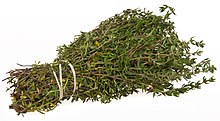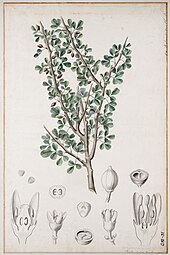Herb

In general use,herbsare a widely distributed and widespread group of plants, excludingvegetablesand other plants consumed formacronutrients,with savory or aromatic properties that are used for flavoring andgarnishingfood, for medicinal purposes, or for fragrances. Culinary use typically distinguishes herbs fromspices.Herbsgenerally refers to theleafygreen orfloweringparts of a plant (either fresh or dried), whilespicesare usually dried and produced from other parts of the plant, includingseeds,bark,rootsandfruits.
Herbs have a variety of uses including culinary, medicinal, aromatic and in some cases, spiritual. General usage of the term "herb" differs between culinary herbs andmedicinal herbs;in medicinal or spiritual use, any parts of the plant might be considered "herbs", including leaves, roots, flowers, seeds, root bark, inner bark (andcambium),resinandpericarp.
The word "herb" is pronounced/hɜːrb/inCommonwealth English,[1]but/ɜːrb/is standard amongAmerican Englishspeakers as well as those from regions whereh-droppingoccurs. InCanadian English,both pronunciations are common.[2]In botany, the noun "herb" refers to a "plant that does not produce a woody stem", and the adjective "herbaceous" means "herb-like", referring to parts of the plant that are green and soft in texture ".[3][4]
"What is a herb?" "The friend of physicians and the praise of cooks."
--Alcuinand his studentCharlemagne[5]
Definition
[edit]
Inbotany,the term herb refers to aherbaceous plant,[6]defined as a small,seed-bearing plantwithout a woody stem in which all aerial parts (i.e. above ground) die back to the ground at the end of eachgrowing season.[7]Usually the term refers toperennials,[6]although herbaceous plants can also beannuals(plants that die at the end of the growing season and grow back from seed next year),[8]orbiennials.[6]This term is in contrast toshrubsandtreeswhich possess a woody stem.[7]Shrubs and trees are also defined in terms of size, where shrubs are less than ten meters tall, and trees may grow over ten meters.[7]The word herbaceous is derived from Latinherbāceusmeaning "grassy", fromherba"grass, herb".[9]
Another sense of the term herb can refer to a much larger range of plants,[10]with culinary, therapeutic or other uses.[6]For example, some of the most commonly described herbs such assage,rosemaryandlavenderwould be excluded from the botanical definition of an herb as they do not die down each year, and they possess woody stems.[8]In the wider sense, herbs may be herbaceous perennials but also trees, subshrubs, shrubs, annuals,lianas,ferns,mosses,algae,[10]lichens,andfungi.[8]Herbalismcan utilize not just stems and leaves but also fruit, roots, bark and gums.[8]Therefore, one suggested definition of an herb is a plant which is of use to humans,[8]although this definition is problematic since it could cover a great many plants that are not commonly described as herbs.
History
[edit]Ancient Greek philosopherTheophrastusdivided the plant world into trees, shrubs, and herbs.[11]Herbs came to be considered in three groups, namelypot herbs(e.g. onions), sweet herbs (e.g. thyme), and salad herbs (e.g. wild celery).[8]During the seventeenth century asselective breedingchanged the plants size and flavor away from the wild plant, pot herbs began to be referred to asvegetablesas they were no longer considered only suitable for the pot.[8]
Botany and the study of herbs was, in its infancy, primarily a study of the pharmacological uses of plants. During the Middle Ages, whenhumoral theoryguided medicine, it was posited that foodstuffs, possessing their own humoral qualities, could alter the humoral temperaments of people. Parsley and sage were often used together in medieval cookery, for example inchicken broth,which had developed a reputation as a therapeutic food by the 14th century. One of the most common sauces of the age,green sauce,was made with parsley and often sage as well. In a 14th-century recipe recorded inLatin"for lords, for settling their temperament and whetting their appetite" green sauce is served with a dish of cheese and whole egg yolks boiled in watered down wine with herbs and spices.[12]
Reproduction
[edit]Perennial herbsare usually reproduced by stem cuttings, either softwood cuttings of immature growth, or hardwood cuttings where the bark has been scraped to expose thecambiumlayer. A cutting will usually be approximately 3 to 4 inches in length. Plant roots can grow from the stems. Leaves are stripped from the lower portion up to one half before the cutting is placed in growth medium or rooted in a glass of water. This process requires high humidity in the environment, sufficient light, and root zone heat.[13]
Uses
[edit]Culinary
[edit]
Culinary herbs are distinguished fromvegetablesin that, like spices, they are used in small amounts and provideflavorrather than substance tofood.[14]
Herbs can be perennials such asthyme,oregano,sageorlavender,biennials such asparsley,or annuals likebasil.Perennial herbs can be shrubs such as rosemary (Rosmarinus officinalis), or trees such asbay laurel(Laurus nobilis) – this contrasts withbotanical herbs,which by definition cannot be woody plants. Some plants are used as both herbs and spices, such asdillweed and dill seed orcorianderleaves and seeds. There are also some herbs, such as those in themint family,that are used for both culinary and medicinal purposes.
EmperorCharlemagne(742–814) compiled a list of 74 different herbs that were to be planted in his gardens. The connection between herbs and health is important already in the European Middle Ages--The Forme of Cury(that is, "cookery" ) promotes extensive use of herbs, including in salads, and claims in its preface "the assent and advisement of the masters of physic and philosophy in the King's Court".[5]
Teas
[edit]Some herbs can be infused in boiling water to makeherbal teas(also termed tisanes).[6][10]Typically the dried leaves, flowers or seeds are used, or fresh herbs are used.[6]Herbal teas tend to be made from aromatic herbs,[11]may not containtanninsorcaffeine,[6]and are not typically mixed with milk.[10]Common examples includechamomile tea,[10]ormint tea.[11]Herbal teas are often used as a source of relaxation or can be associated with rituals.[11]
Medicine
[edit]

Herbs were used inprehistoric medicine.As far back as 5000 BCE, evidence thatSumeriansused herbs in medicine was inscribed on cuneiform.[16]In 162 CE, the physicianGalenwas known for concocting complicated herbal remedies that contained up to 100 ingredients.[17]
Some plants containphytochemicalsthat have effects on the body. There may be some effects when consumed in the small levels that typify culinary "spicing", and some herbs are toxic in larger quantities. For instance, some types of herbal extract, such as the extract of St. John's-wort (Hypericum perforatum) or of kava (Piper methysticum) can be used for medical purposes to relieve depression and stress.[18]However, large amounts of these herbs may lead to toxic overload that may involve complications, some of a serious nature, and should be used with caution. Complications can also arise when being taken with some prescription medicines.
Herbs have long been used as the basis of traditionalChinese herbal medicine,with usage dating as far back as the first centuryCEand far before. In India, theAyurvedamedicinal system is based on herbs. Medicinal use of herbs in Western cultures has its roots in theHippocratic(Greek) elemental healing system, based on a quaternary elemental healing metaphor. Famous herbalist of the Western tradition includeAvicenna(Persian),Galen(Roman),Paracelsus(German Swiss),Culpepper(English) and the botanically inclined Eclectic physicians of 19th century/early 20th century America (John Milton Scudder,Harvey Wickes Felter,John Uri Lloyd). Modern pharmaceuticals had their origins in crude herbal medicines, and to this day, some drugs are still extracted as fractionate/isolate compounds from raw herbs and then purified to meet pharmaceutical standards.
There is a record dated 1226 for '12d for Roses for Baron's Chamber and in 1516 for flowers and rushes for chambers for henry the 9th[6]
Certain herbs contain psychoactive properties that have been used for both religious and recreational purposes by humans since the earlyHoloceneera, notably the leaves and extracts of thecannabisandcocaplants. The leaves of the coca plant have been chewed by people in northernPeruviansocieties for over 8,000 years,[19]while the use of cannabis as a psychoactive substance dates back to the first century CE inChinaand northernAfrica.[20]
Indigenous Australianpeoples developed "bush medicine"based on plants that were readily available to them. The isolation of these groups meant the remedies developed were for far less serious diseases than the western illnesses they contracted during colonisation. Herbs such asriver mint,wattleandeucalyptuswere used for coughs, diarrhea, fever and headaches.[17]
Ritual
[edit]
Herbs are used in manyreligions.During the monastic era, monks would cultivate herbs alongside vegetables, while others would be set aside in aphysic gardenfor specific purposes.[21]For example,myrrh(Commiphora myrrha) andfrankincense(Boswelliaspecies) inHellenistic religion,thenine herbs charminAnglo-Saxon paganism,neem(Azadirachta indica) leaves,bael(Aegele marmelos) leaves, holy basil ortulsi(Ocimum tenuiflorum),turmericor "haldi" (Curcuma longa),cannabisinHinduism,andwhite sageinWicca.Rastafarialso considercannabisto be a holy plant.
Siberianshamansalso used herbs for spiritual purposes. Plants may be used to induce spiritual experiences for rites of passage, such asvision questsin someNative Americancultures. TheCherokeeuse bothwhite sageandcedarfor spiritual cleansing andsmudging.
Cosmetics
[edit]Originally there was always doubt in ancient societies, especially in the sceptical medium of western traditions, as to the efficacity of herbal medicines. The use ofherbal cosmeticsdates back to around six centuries ago in the European and Western countries. Mixtures and pastes were often concocted to whiten the face. During the 1940s, herbal cosmetics took a turn with the emerging red lipstick color, with every year gaining a more intense red. Herbal cosmetics come in many forms, such as face creams, scrubs, lipstick, natural fragrances, powders, body oils, deodorants and sunscreens. They activate through the epithelium of sebaceous glands to make the skin more supple. Ayurvedic oils are widely used in India, prized for their natural health-giving properties.[22]
One method and perhaps the best, used to extract natural oils from herbs to make lipstick ispartition chromatography.The process involves separation in watery solution, and then the injection of colour under pressure.
Other
[edit]Strewing herbs are scattered (strewn) over the floors of dwelling places and other buildings. Such plants usually have fragrant or astringent smells, and many also serve as insecticides (e.g. to repel fleas) or disinfectants. For example,meadowsweet(Filipendula ulmaria) was sometimes strewn across floors in the Middle Ages because of its sweet smell.[10]
See also
[edit]References
[edit]- ^"Herb".Cambridge Advanced Learners' Dictionary & Thesaurus.Cambridge University Press.
- ^"'H' an ingredient of modern herb ".Toronto Star. 12 October 2009.Retrieved2 June2023.
- ^Carolin, Roger C.; Tindale, Mary D. (1994).Flora of the Sydney region(4th ed.). Chatswood, NSW: Reed. p. 23.ISBN0730104001.
- ^"Glossary of Botanical Terms".Royal Botanic Garden Sydney.Retrieved8 March2021.
- ^abFreeman, Margaret B. (1943).Herbs for the Medieval Household, for Cooking, Healing and Divers uses.New York: The Metropolitan Museum of Art. pp. ix–x.
- ^abcdefghThe Royal Horticultural Society encyclopedia of gardening(2nd ed.). Dorling Kindersley. 2004. pp. 404, 679.ISBN9781405303538.
- ^abcAllaby, Michael (2012).A Dictionary of Plant Sciences.Oxford University Press.ISBN9780191079030.
- ^abcdefgStuart, Malcolm (1989).The Encyclopedia of herbs and herbalism.Crescent Books. p. 7.ISBN978-0517353264.
- ^Oxford dictionary of English(3rd ed.). Oxford University Press. 2010. p. 819.ISBN9780199571123.
- ^abcdefBown, Deni (1995).Encyclopedia of herbs & their uses.Dorling Kindersley. pp.10,11.ISBN978-0751302035.
- ^abcdBremness, Lesley (1994).The complete book of herbs.Viking Studio Books. p. 8.ISBN9780140238020.
- ^ Health and Healing From the Medieval Garden.The Boydell Press. 2008. p. 67.ISBN9781843833635.
- ^Tucker, Arthur; Debaggio, Thomas.The Encyclopedia of Herbs.London: Timber Press.
- ^Small, E.; National Research Council Canada (2006).Culinary Herbs.NRC Research Press. p. 1.ISBN978-0-660-19073-0.Retrieved9 October2018.
- ^Patrick Curry: "Culpeper, Nicholas (1616–1654)",Oxford Dictionary of National Biography(Oxford, UK: OUP, 2004)
- ^Wrensch, Ruth D. (1992).The Essence of Herbs.University Press of Mississippi. p. 9.
- ^abTapsell LC, Hemphill I, Cobiac L, Sullivan DR, Fenech M, Patch CS, Roodenrys S, Keogh JB, Clifton PM, Williams PG, Fazio VA, Inge KE (2006)."Health benefits of herbs and spices: The past, the present, the future".Medical Journal of Australia.185(4): S1–S24.doi:10.5694/j.1326-5377.2006.tb00548.x.hdl:2440/22802.PMID17022438.S2CID9769230.
- ^Adele G Dawson (2000).Herbs, Partners in Life: Healing, Gardening and Cooking with Wild Plants.Bear & Co. pp. 5–6.
- ^Dillehay T, Rossen J, Ugent D, Karathanasis A, Vásquez V, Netherly P (2010). "Early Holocene coca chewing in northern Peru".Antiquity.84(326): 939–953.doi:10.1017/S0003598X00067004.S2CID162889680.
- ^Ernest Abel (1980).Marihuana: The First Twelve Thousand Years(PDF).New York: Springer.ISBN978-0-306-40496-2.Retrieved2018-07-25.
- ^Cooper, Guy; Taylor, Gordon I. (1986).English Herb Garden.Random House.
- ^Panda, H. (2015).Herbal Cosmetics Handbook(3rd ed.). Asia-Pacific Business Press.
External links
[edit] Media related toHerbsat Wikimedia Commons
Media related toHerbsat Wikimedia Commons- § 182.10 Spices and other natural seasonings and flavorings that are generally recognized as safeArchived2018-02-09 at theWayback Machine,US Code of Federal Regulations
